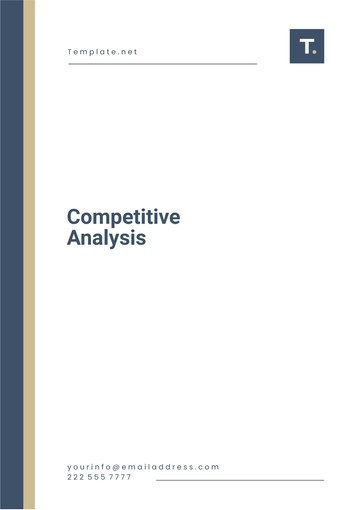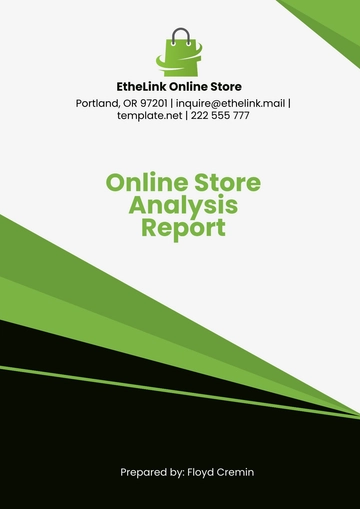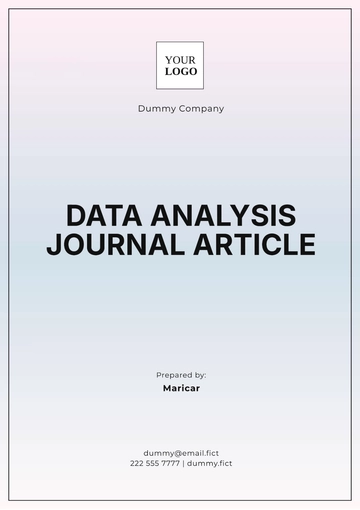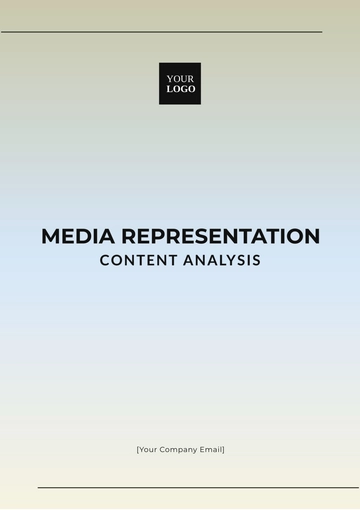Free Restaurant Equipment Analysis

I. Executive Summary
The objective of this Restaurant Equipment Analysis is to provide an in-depth examination of the current equipment used at [Your Company Name], identify inefficiencies, and recommend improvements. This analysis is designed to help [Your Company Name] optimize its equipment usage, minimize maintenance costs, and enhance overall operational efficiency. By scrutinizing current equipment management practices, utilization rates, and associated costs, we can offer actionable recommendations to boost equipment performance and reliability.
This analysis explores the performance and utilization of critical equipment, categorizing them into high-demand, essential, and low-demand items. Additionally, we assess maintenance strategies and costs, focusing on preventive maintenance, reactive repairs, and equipment lifespan. The recommendations are aimed at helping [Your Company Name] adopt best practices in equipment management, such as implementing a comprehensive maintenance program, investing in energy-efficient equipment, and regularly evaluating equipment performance. These steps will ensure improved equipment control, reduced downtime, and enhanced profitability. Through this analysis, [Your Company Name] can make informed decisions to streamline operations and bolster its competitive position.
II. Current Equipment Management Practices
This section examines the existing equipment management practices at [Your Company Name]. We review the methods used for tracking equipment, analyze utilization rates, and assess the costs involved. Understanding current practices is crucial for identifying areas that need improvement and implementing effective strategies.
A. Equipment Tracking Methods
Manual Tracking
Manual tracking involves physically recording equipment details and maintenance schedules on paper or simple spreadsheets. While this method is straightforward, it is prone to human error, time-consuming, and challenging to scale as the inventory grows.
Spreadsheet Management
Many restaurants, including [Your Company Name], use spreadsheet software such as Excel or Google Sheets to manage equipment. This method offers better organization than manual tracking but still requires substantial manual data entry and is susceptible to errors.
Equipment Management Software
Investing in equipment management software can streamline processes, enhance accuracy, and provide real-time data. These software solutions offer features like automated maintenance scheduling, inventory tracking, and detailed reporting, aiding in informed decision-making.
B. Equipment Utilization Rates
The table below displays the equipment utilization rates for [Your Company Name] over the past six months. The utilization rate is a critical metric that indicates how often equipment is used within a given period. A higher rate signifies efficient usage, whereas a lower rate may suggest underutilization or inefficiencies.
Table 1: Equipment Utilization Rate (Last 6 months)
Month | Utilization Rate |
|---|---|
January | 75% |
February | 80% |
March | 78% |
April | 82% |
May | 85% |
June | 80% |
C. Equipment Costs
Equipment costs can be divided into three primary categories: acquisition costs, maintenance costs, and operational costs. Understanding these expenses is vital for effective equipment management.
Acquisition Costs
Acquisition costs cover the expenses related to purchasing new equipment. Efficient management can help reduce these costs by extending the lifespan of existing equipment and making well-informed purchasing decisions.
Maintenance Costs
Maintenance costs encompass the expenses required to keep equipment in optimal working condition, including preventive maintenance, repairs, and spare parts. Implementing a comprehensive maintenance program can reduce these costs by preventing major breakdowns and extending equipment lifespan.
Operational Costs
Operational costs include expenses associated with the daily use of equipment, such as energy consumption and labor. Investing in energy-efficient equipment and optimizing usage can help lower these costs.
III. Analysis of Equipment Data
In this section, we analyze equipment data to understand utilization patterns, maintenance needs, and overall performance. This analysis helps identify high-demand, essential, and low-demand equipment, as well as areas where maintenance can be optimized.
A. Equipment Utilization
Understanding equipment utilization helps determine which items are in high demand, essential for operations, or underutilized. This information is crucial for making informed decisions about equipment purchases and maintenance schedules.
High-Demand Equipment
High-demand equipment is used frequently in daily operations. Ensuring these items are well-maintained and functioning efficiently is vital to prevent operational disruptions.
Essential Equipment
Essential equipment is necessary for core restaurant functions but may not be used as often as high-demand items. Regular maintenance is still crucial to ensure reliability and performance.
Low-Demand Equipment
Low-demand equipment is seldom used and may not be critical for daily operations. Identifying and evaluating the necessity of these items can help reduce unnecessary maintenance and operational costs.
B. Maintenance Analysis
Maintenance analysis involves identifying areas where maintenance practices can be optimized, such as preventive maintenance, reactive repairs, and equipment lifespan management.
Preventive Maintenance
Preventive maintenance includes regularly scheduled activities designed to prevent equipment failures and extend lifespan. Implementing a preventive maintenance program can reduce unexpected repairs and downtime.
Reactive Repairs
Reactive repairs are conducted in response to equipment malfunctions or failures. While some reactive repairs are unavoidable, their frequency can be minimized through effective preventive maintenance.
Equipment Lifespan
Understanding the expected lifespan of equipment assists in planning for replacements and budgeting for future purchases. Regular evaluations of equipment performance and condition can help identify when items are nearing the end of their useful life.
C. Cost-Benefit Analysis
A cost-benefit analysis evaluates the financial impact of current equipment management practices and identifies potential savings through improved practices.
Energy Efficiency
Investing in energy-efficient equipment can help reduce operational costs and improve sustainability. Comparing the energy consumption of existing equipment with newer, more efficient models can highlight potential savings.
Downtime Reduction
Reducing equipment downtime through regular maintenance and timely repairs can enhance overall operational efficiency and decrease costs associated with disruptions.
Spare Parts Management
Effective management of spare parts inventory ensures that necessary components are available for repairs, reducing downtime and improving maintenance efficiency.
IV. Recommendations
Based on the analysis, we provide several recommendations to improve equipment management at [Your Company Name]. These include implementing a comprehensive maintenance program, investing in energy-efficient equipment, and regularly evaluating equipment performance to ensure efficient and cost-effective operations.
A. Implement a Comprehensive Maintenance Program
Adopting a comprehensive maintenance program can help prevent unexpected equipment failures and extend equipment lifespan. This program should include regular preventive maintenance, timely repairs, and a robust spare parts management system.
B. Invest in Energy-Efficient Equipment
Investing in energy-efficient equipment can help reduce operational costs and improve sustainability. Evaluating the energy consumption of existing equipment and replacing outdated models with energy-efficient alternatives can result in significant cost savings.
C. Regular Equipment Performance Evaluations
Regularly evaluating equipment performance helps identify issues early and ensures equipment is functioning optimally. Implementing performance metrics and regular inspections can help maintain equipment reliability and efficiency.
D. Optimize Equipment Utilization
Optimizing equipment utilization involves ensuring that high-demand and essential equipment is always available and functioning efficiently while reducing unnecessary maintenance for low-demand items. This can help improve operational efficiency and reduce costs.
E. Supplier Evaluation and Negotiation
Evaluating and possibly renegotiating terms with equipment suppliers can improve reliability and reduce costs. Building strong relationships with reliable suppliers ensures consistent product quality and timely deliveries.
V. Conclusion
By addressing the identified inefficiencies and implementing the recommended improvements, [Your Company Name] can better manage its equipment, reduce costs, and enhance overall operational efficiency. Effective equipment management is crucial for maintaining operational continuity, reducing downtime, and improving profitability. Through this analysis, [Your Company Name] can make informed decisions to streamline operations and enhance its competitive edge.
VI. Contact Information
For further information or inquiries, please contact:
Name: [Your Name]
Email: [Your Company Email]
Phone: [Your Company Number]
- 100% Customizable, free editor
- Access 1 Million+ Templates, photo’s & graphics
- Download or share as a template
- Click and replace photos, graphics, text, backgrounds
- Resize, crop, AI write & more
- Access advanced editor
Enhance your restaurant's operational efficiency with Template.net's Restaurant Equipment Analysis Template. This dynamic tool enables comprehensive evaluation of equipment performance, maintenance needs, and cost-effectiveness. Fully editable and customizable with our intuitive AI editor tool, it allows you to tailor the analysis to suit your restaurant's unique requirements. Streamline equipment management and maximize productivity, exclusively at Template.net.





























